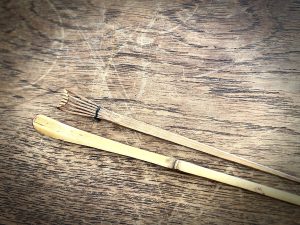はたして茶杓はつくれるのか(愛知県名古屋市千種区姫池通 骨董買取 古美術風光舎)
2025.08.28

先日、茶杓を自分でつくってみようという講座が目にとまりました。たぶん上手く作れるはずはないのですがちょっと気になっています。
そもそも茶道は手習い程度の素人でお稽古は終了したのですが、茶道というのは所作やお道具のそれぞれのストーリを嗜み楽しむところに醍醐味や奥ゆかしさがあるな…などと習いながら思ったことを思い出しましたが、茶杓のストーリもそのひとつでして。
そもそも中国の象牙の薬匙が原型で鎌倉時代初めまでは薬用の小道具として使われていました茶杓、室町時代中期に村田珠光が薬匙の形を参考に高価な象牙の代わりに竹に漆を塗ったものが現在の形の原型となるようですが、その時に茶杓を作り始める茶杓削りが本格的が始まったよう。
その後、千利休が中央に節のある中節の茶杓を編み出し、現代の一般的な茶杓の形が確立され茶の湯のスタンダードとなっていくわけですが、かつては茶杓は一度の茶会のために自ら毎回新しく作るお道具でもあったようで、このストーリにもなかなか奥ゆかしいものがありますよね。
一説によると、戦国時代に茶会に招いて楽しく過ごした相手が戦で死ぬことも敵味方になることもあり、本当に一期一会を実感する時代においては一度のお茶会は大切な場面であります。心を込めて茶杓を削りその時の思いを込めて銘をつけていたようですね。千利休の登場以前こうやって茶会ごとに茶杓を削って作り使い終わると捨てることが一般的でしたが、千利休以降は先生や尊敬する茶人の茶杓を保存・愛用することが多くなり、現在では茶杓師が制作した茶杓を大切に使うことが主流となっています。千利休の「泪」などは代表的な銘品のひとつですよね。
小さなお道具の一つではあるのですが、毎回の客人を迎えるまでの時間や手間を考えると、おもてなしや敬意がつまったお道具なんじゃないかな…なんて思うわけで。
自分が茶会などひらくわけではないのですが、客人をこれからもてなす主人になりきって茶杓を作るという疑似体験がしてみたいわけでして。たとえ作ったとしても、出来上がったぶざまな茶杓はちょっとお見せできませんが。
それではごきげんよう、(スタッフY)
Recently, a course on how to make your own chashaku (tea scoop) caught my eye. I’m sure I wouldn’t be able to make a good one, but I’m intrigued. I’m just a beginner when it comes to the tea ceremony, and my lessons have already ended, but I remember how much I enjoyed the beauty and grace of it all—the shosa (manners) and the individual stories behind each of the tools. The story of the chashaku is one of those.
The chashaku was originally an ivory medicine spoon from China and was used as a small medical tool until the early Kamakura period. In the mid-Muromachi period, Murata Juko is said to have used the shape of a medicine spoon as a model, creating the prototype of today’s chashaku by applying lacquer to a bamboo stick instead of expensive ivory. It was at this time that chashaku carving, or “chashaku-kezuri,” began in earnest.
Later, Sen no Rikyu invented the “chusetsu” style of chashaku, with a knot in the middle, which established the modern standard for the tea ceremony. In the past, it seems a new chashaku was made for each tea gathering, a story that holds a quiet, profound elegance.
According to one theory, in the Sengoku period, a guest you had a pleasant tea gathering with could die in battle or become an enemy. In such a time when “ichigo ichie” (once-in-a-lifetime encounter) was truly felt, a single tea gathering was a precious occasion. It is said that the host would carve the chashaku with great care, putting their feelings into it, and giving it a name (mei). Before Sen no Rikyu, it was common to carve a new chashaku for each tea gathering and then discard it after use. After Rikyu, however, it became more common to preserve and cherish the chashaku of one’s teacher or respected tea master. Today, it is most common to carefully use a chashaku made by a professional chashakushi (tea scoop artisan). Rikyu’s “Namida” (Tears) is one of the most famous examples.
Though it’s a small tool, when you consider the time and effort it took to prepare for each guest, I can’t help but feel it’s a tool filled with hospitality and respect.
I don’t host tea ceremonies myself, but I would love to have the pseudo-experience of making a chashaku as if I were a host preparing to welcome a guest. Even if I do make one, I probably won’t be able to show off my clumsy creation… LOL.
All the best, (Staff Y)
*******************
ご実家の整理やお片付けなどをされている方のご相談などが多くございます。
お片付けなどくれぐれもご無理のないようになさってくださいませ。
風光舎では古美術品や骨董品の他にも絵画や宝石、趣味のお品など様々なジャンルのものを買受しております。
お片付けをされていて、こういうものでもいいのかしらと迷われているものでも、どうぞお気軽にご相談下さいませ。
また風光舎は、出張買取も強化しております。ご近所はもちろん、愛知県内、岐阜県、三重県その他の県へも出張いたします。
まずは、お電話お待ちしております。
愛知県名古屋市千種区姫池通
骨董 買取【古美術 風光舎 名古屋店】
TEL052(734)8444
10:00-18:00 OPEN

